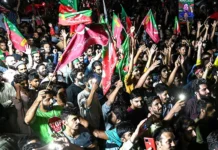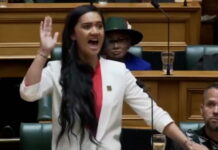Have you ever wondered what drives the complex machinery of American politics? The political landscape in the United States is vast, intricate, and often puzzling. Understanding “the logic of American politics” requires peeling back layers of systems, institutions, and ideologies. This article will delve deep into the core structures that shape American politics, providing insight into how power is distributed, who holds it, and the rules that govern its exercise. Stick around, and by the end, you’ll be well-equipped to navigate the fascinating world of American political logic!
Table of Contents
ToggleIntroduction to the Logic of American Politics
The logic of American politics can be summarized by a single question: Who gets what, when, and how? This framework drives the decisions made within the U.S. political system. But what are the deeper rules, the underlying mechanisms that guide how power is shared and how decisions are made?
In this article, we will examine how institutions, democracy, federalism, and political parties work in tandem to shape the American political landscape. We’ll also explore key issues like checks and balances, elections, and the influence of media and public opinion.
The Foundations of American Politics
Before diving into the intricacies of American politics, it’s crucial to grasp its foundation. The U.S. Constitution, created over 200 years ago, still serves as the supreme law of the land. Understanding the Constitution is key to understanding the rules of American political behavior. How do institutions like Congress, the presidency, and the courts function within this framework?
The Role of the U.S. Constitution
The Constitution sets the stage for American politics by outlining the structure of government, the separation of powers, and the rights of citizens. It establishes the legislative, executive, and judicial branches, each with specific duties and limitations. This separation of powers ensures that no single branch becomes too powerful, a principle known as “checks and balances.”
- The Legislative Branch: Made up of Congress (the Senate and the House of Representatives), it is responsible for making laws.
- The Executive Branch: Led by the President, it enforces laws and oversees the federal government.
- The Judicial Branch: Composed of the courts, including the Supreme Court, it interprets the Constitution and ensures that laws comply with it.
Federalism in America
Federalism, the division of power between the national government and the states, is another critical aspect of American politics. This system allows for both national and state governments to exercise authority, often leading to debates about states’ rights versus federal control. These tensions are seen in issues ranging from healthcare to education to environmental regulations.
The Power of Political Institutions
Political institutions are the backbone of the U.S. political system. These institutions organize, distribute, and regulate political power within the nation. Let’s take a closer look at some of the key political bodies.
Congress – The Lawmaking Body
Congress, as the primary legislative body, plays a critical role in the decision-making process. It is divided into two chambers: the House of Representatives and the Senate.
- The House of Representatives: With 435 members, it represents districts based on population size. Representatives serve two-year terms, making the House more responsive to changes in public opinion.
- The Senate: Consisting of 100 members, two from each state, senators serve six-year terms. The Senate is considered more stable and deliberate, balancing the more reactive House.
Both chambers must work together to pass laws, but they often clash due to political differences, leading to the famous “gridlock” that American politics is known for.
The Presidency – Executive Power
The President, as head of the executive branch, holds significant power but is also bound by the Constitution. The President enforces laws, oversees the military as Commander-in-Chief, and works with Congress to pass legislation. However, the President is limited by checks from Congress and the courts. This balance ensures that executive power does not go unchecked, as history has shown the dangers of consolidating too much power in one office.
The Role of Political Parties
Political parties are essential in organizing political activity and providing a platform for citizens to engage in the political process. In the U.S., two main parties dominate: the Democratic Party and the Republican Party.
H3: Democrats vs. Republicans – Key Differences
- Democrats tend to favor more government intervention in areas like healthcare, education, and environmental policy. They are often seen as more progressive on social issues.
- Republicans generally advocate for limited government, free-market capitalism, and more conservative social policies. They prioritize issues like tax cuts, deregulation, and national security.
The competition between these two parties has shaped American politics for centuries, influencing elections, policy-making, and public opinion.
Third Parties – Influence and Challenges
While the U.S. is primarily a two-party system, third parties occasionally play a role, especially in local elections or by drawing attention to specific issues. However, due to structural barriers and the “winner-takes-all” electoral system, third parties face significant challenges in gaining traction.
Elections and Voter Participation
Elections are the primary means by which citizens influence the political process. From presidential elections to local school board races, voters have a say in who represents them.
Presidential Elections
Every four years, the U.S. elects a President through the Electoral College system. This system allocates electoral votes based on state population, with the candidate who wins the majority of votes in a state generally taking all of its electoral votes. This unique system has its critics, as it can result in a President being elected without winning the popular vote.
Midterm Elections
In between presidential elections, midterm elections are held for Congress. These elections can shift the balance of power in the legislative branch and are often seen as a referendum on the sitting President’s performance.
Voter Turnout and Challenges
Voter turnout in the U.S. is often lower than in other democracies, especially in midterm elections. Various factors influence voter participation, including voter ID laws, access to polling places, and the perceived importance of the election. Recent efforts to restrict or expand voting rights have sparked heated debates about the future of American democracy.
The Influence of the Media and Public Opinion
In today’s political landscape, the media plays a crucial role in shaping public opinion and political outcomes. From traditional news outlets to social media platforms, how Americans consume information can significantly impact elections and policy decisions.
Media Bias and Political Polarization
The rise of partisan media has led to increased political polarization. News outlets often cater to specific political ideologies, reinforcing existing beliefs rather than providing balanced perspectives. This phenomenon has contributed to the deep political divisions seen in American society today.
The Role of Social Media
Social media has become a powerful tool in modern politics, allowing politicians to communicate directly with voters and bypass traditional media. However, it has also been criticized for spreading misinformation and contributing to political echo chambers where people only engage with content that aligns with their views.
Public Opinion and Its Impact on Policy
Public opinion, shaped by factors like the media, education, and personal experience, plays a significant role in influencing political decisions. Politicians often rely on opinion polls to gauge the views of their constituents, adjusting their policies and rhetoric accordingly.
Checks and Balances in Action
One of the most defining features of American politics is the system of checks and balances. This principle ensures that no one branch of government becomes too powerful. Each branch has the authority to limit the power of the others, creating a balance that maintains the integrity of the system.
- Congress can pass laws, but the President can veto them.
- The President can issue executive orders, but the courts can strike them down if deemed unconstitutional.
- The Supreme Court interprets laws, but Congress can amend the Constitution or pass new laws to address judicial rulings.
The Role of Interest Groups and Lobbyists
Interest groups and lobbyists play a significant role in shaping policy in the U.S. Interest groups represent specific causes or industries, such as healthcare, energy, or civil rights. They use lobbying and campaign contributions to influence lawmakers and promote their agendas.
Influence of Money in Politics
Money plays a crucial role in American politics, especially in elections. Political action committees (PACs) and super PACs raise and spend vast sums of money to support or oppose candidates. Critics argue that this gives wealthy individuals and corporations too much influence over the political process, while others claim that it’s a necessary part of free speech and political participation.
The Future of American Politics
As American politics continues to evolve, questions remain about the future of democracy in the U.S. The growing political polarization, challenges to voting rights, and the increasing influence of money and media have all raised concerns about the health of the political system. However, the strength of American institutions and the resilience of the Constitution provide hope that the system can adapt to meet new challenges.
Reforming the Electoral System
One of the most discussed potential reforms is the modification or abolition of the Electoral College. Critics argue that the current system doesn’t reflect the popular will, as seen in several recent elections where a candidate won the Electoral College but lost the popular vote. Proposals for reform include transitioning to a popular vote system or revising how electoral votes are allocated to better represent the population.
Addressing Political Polarization
Political polarization remains a significant challenge for American democracy. The widening gap between the Democratic and Republican parties has led to increased gridlock in Congress and less cooperation between lawmakers. Some scholars and politicians have called for reforms such as ranked-choice voting, open primaries, and non-partisan redistricting to help reduce polarization and encourage more moderate, bipartisan candidates.
The Role of Technology in Future Elections
As technology advances, its role in politics will only grow. Online voting systems, improved transparency in campaign finance, and AI-driven data analysis are potential areas where technology could reshape the political process. However, these advances also come with concerns about cybersecurity, misinformation, and privacy. Ensuring the integrity of elections in an increasingly digital world will be a key challenge in the years to come.
Civic Engagement and Its Importance
The foundation of any democracy is active civic engagement. The health of American democracy depends on citizens who are informed, engaged, and ready to participate in the political process. Voting, advocating for issues, and holding elected officials accountable are vital components of a functioning democracy.
Education and Political Awareness
One of the best ways to encourage civic engagement is through education. By fostering a deeper understanding of the political system, citizens are better equipped to make informed decisions. Civic education programs, both in schools and through community organizations, play an essential role in preparing future generations to take part in the democratic process.
Grassroots Movements
Grassroots movements have long played a significant role in American politics. From the civil rights movement to more recent pushes for climate action and racial justice, these movements show the power of collective action. In an increasingly polarized and complex political environment, grassroots organizations offer a way for ordinary citizens to have a voice and drive change.
The Role of Young Voters
Younger generations are becoming more politically active, and their participation is crucial for the future of American politics. Issues such as climate change, student debt, and social justice are particularly important to younger voters, and their growing influence in elections could shift the political landscape. Encouraging young people to vote and remain engaged in political issues will help ensure that their voices are heard in shaping the future.
Challenges to American Democracy
While American democracy has proven resilient, it faces several ongoing challenges. From political polarization to threats to voting rights, these challenges will require thoughtful solutions and robust public participation.
Voting Rights and Access
Voting rights remain a contentious issue in American politics. Recent efforts to pass voter ID laws and restrict early voting have sparked debates about the accessibility of the democratic process. Supporters of these measures argue they prevent voter fraud, while opponents claim they disproportionately affect minority and low-income voters. Ensuring that every eligible voter has access to the ballot is essential for maintaining a fair and just political system.
The Influence of Money in Politics
As previously mentioned, the role of money in politics continues to raise concerns about the fairness of the political system. The Citizens United Supreme Court decision, which allowed unlimited spending by corporations and unions in political campaigns, has amplified fears that wealthy individuals and special interest groups have too much influence over elections and policy decisions. Addressing campaign finance reform will be a critical issue in the years ahead.
Misinformation and the Media
In the digital age, the spread of misinformation has become a significant threat to democratic governance. Social media platforms, while providing opportunities for direct engagement with the public, have also been vehicles for spreading false information, conspiracy theories, and divisive rhetoric. Combating misinformation while preserving free speech will be a difficult but necessary task for preserving the integrity of American politics.
Conclusion: The Future of American Politics
The logic of American politics is dynamic, multifaceted, and constantly evolving. At its core, it is about power—how it is distributed, who wields it, and the rules that govern its exercise. By understanding the structures, institutions, and processes that shape American politics, we gain insight into the larger questions of governance, representation, and accountability.
As the United States faces new challenges—political polarization, technological change, and global uncertainty—its political system must adapt. Reforms to the electoral process, a renewed emphasis on civic engagement, and addressing the influence of money and misinformation in politics will be essential for the future. However, the resilience of American institutions and the active participation of its citizens provide a foundation for hope.
In the end, the logic of American politics is not just about who holds power, but how the system ensures that power is used in the service of the people. The key to navigating this complex landscape lies in staying informed, engaged, and ready to participate in the ongoing experiment of American democracy.
FAQs
- What is the logic of American politics?
The logic of American politics revolves around power—how it is distributed, who holds it, and how decisions are made. It is governed by systems and institutions that ensure checks and balances, with the Constitution serving as the foundational framework. - What are the main political institutions in the U.S.?
The main political institutions include Congress (the legislative body), the Presidency (executive power), and the Courts (judicial power). These institutions work together, often with competing interests, to ensure no one branch becomes too powerful. - Why is federalism important in American politics?
Federalism divides power between the national government and state governments, allowing for a balance of authority. It plays a key role in debates over states’ rights and the reach of federal power on issues like healthcare, education, and the environment. - What is the role of political parties in the U.S.?
Political parties organize political activity, provide platforms for voters to align with, and influence elections and policy decisions. The two main parties—Democrats and Republicans—dominate the political landscape, though third parties occasionally play a role. - How does the Electoral College work in U.S. elections?
The Electoral College allocates electoral votes to each state based on population size. Candidates who win the majority of votes in a state typically take all its electoral votes, determining the winner of the presidential election. This system has faced criticism for not always reflecting the popular vote.


















